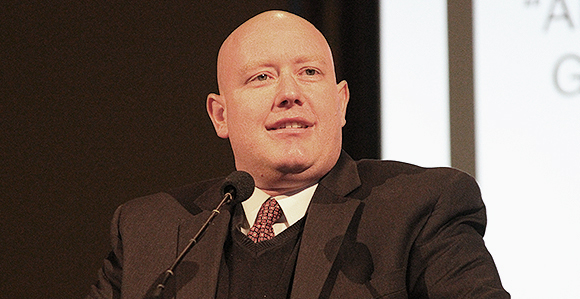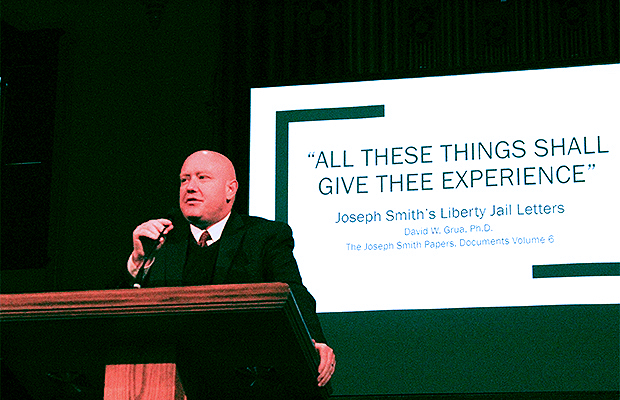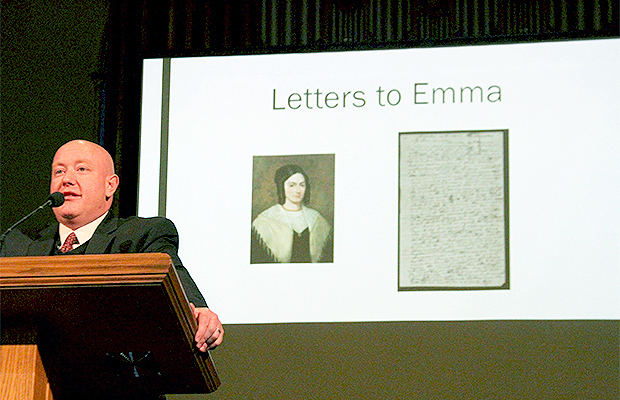New Installment of Joseph Smith Papers Includes Letters from Liberty Jail
Contributed By R. Scott Lloyd, Church News staff writer

David W. Grua, a volume editor of the latest Joseph Smith Papers release, discusses the Liberty Jail letters of Joseph Smith, the topic of that new volume in a lecture at the Assembly Hall on Temple Square September 28, 2017.
Article Highlights
- The latest installation of the Joseph Smith Papers was released September 25.
- During his time in Liberty Jail, Joseph Smith wrote five letters to the Church and five letters to his wife Emma.
- Parts of these letters became Doctrine and Covenants 121–123.
Related Links
Written from the crucible of his confinement in Liberty Jail, Missouri, in 1839, Joseph Smith penned some of the most sublime doctrine in holy writ.
“All these things shall give thee experience,” “many are called, but few are chosen,” and “thy scepter shall be an unchanging scepter of righteousness” are a few of the phrases familiar to Latter-day Saints from Doctrine and Covenants 121–123, taken from two of the letters Joseph wrote while in the jail.
“Most people don’t know that he wrote 10 letters while he was in Missouri state custody,” said David W. Grua in a lecture at the Assembly Hall on Temple Square in Salt Lake City on September 28.
“My hope is that by the end of our time together tonight, you will have a better understanding and appreciation of … the 10 letters that Joseph Smith wrote. I would also like to give you a glimpse into some of the Latter-day Saints who in 1839 read Joseph Smith’s letters, and, lucky for us, they wrote about what they thought when they read the Prophet’s letters.”
Grua, who holds a doctorate in American history from Texas Christian University and is a resident historian at the Church History Department, is one of five volume editors of the latest release in the Joseph Smith Papers.
Documents, Volume 6 was released Monday, September 25. It covers February 1838 through August 1839 and includes letters, minutes of meetings, revelations, land transaction records, and accounts of discourses. It covers the “Mormon War” in Missouri, the expulsion of the Latter-day Saints from the state, Joseph Smith’s time in Liberty Jail, and the initial settlement of the Nauvoo, Illinois, area.
Grua set the stage by talking about the violent conflict that exploded in mid-1838 between Mormons and their neighbors in northwestern Missouri.
“For most of this period, there had been tension and anxiety between Church members and non-Mormons who misunderstood the Saints,” Grua explained. “But by October of 1838, civil authority had essentially broken down, and there was no law enforcement in northwestern Missouri to speak of.”
Thus emboldened, anti-Mormons attacked the Saints. In response, Church members organized in self-defense. Buildings were burned, people were driven from their homes, and innocent people suffered on both sides, Grua said.
“Most tragically, 17 men and boys were killed at Hawn’s Mill, including one of my ancestors,” he said.
Much of what today might be called “fake news” reached Missouri Governor Lilburn W. Boggs in Jefferson City, who, based on the false reports, issued what is known today as the Extermination Order, mandating that the Latter-day Saints be “exterminated” or driven from the state, Grua said.
As a result, 3,000 state militiamen mobilized at Far West. Joseph Smith and other Church leaders were arrested and charged with various offenses, including treason.
Joseph was taken into custody, and the Latter-day Saints were given until the spring to get out of the state or face consequences.
Ultimately, Joseph and associates Hyrum Smith (his brother), Lyman Wight, Sidney Rigdon, Alexander McRae, and Caleb Baldwin were committed to the Clay County Jail, popularly known as the Liberty Jail. The Prophet would spend the next four and a half months there.
“More than anything else, the Prophet Joseph had time to contemplate, to ponder, and to ask questions about why things had gone so terribly wrong in Missouri,” Gura said. “He was also able to contemplate the situation of his people. Today, we would describe the situation in and around Far West as a refugee crisis.”
Their suffering was spiritual as well as physical, he noted. “Each of them had left their homes elsewhere in the United States and had gathered to Missouri, believing strongly, fervently, that Missouri was the site of Zion, the New Jerusalem. They believed they were going there to build Zion, and instead, they had suffered a massive calamity and were being forced out of the state.”
Asked if she yet believed that Joseph Smith was a prophet, Eliza R. Snow replied, “I have not seen or heard anything which caused me to doubt it even for a moment. If possible, I have better testimony that Joseph Smith is a prophet than that Jeremiah was one.”
But the crisis divided Church members, some of whom decided to leave the Church.
The people were desperate for Joseph’s leadership, “and that’s what these letters provided,” Grua explained.
Church members are blessed today to have five letters that Joseph wrote from the jail to his wife Emma Smith in his own hand that have survived, Grua noted.
“Joseph rarely wrote anything in his own hand. … He almost always relied on a scribe,” he said. “We have some reason to believe that Joseph saw writing to Emma Smith in his own hand as part of his husbandly duty. That may explain why he wrote these himself.”
He added, “Joseph’s letters to his wife were intended to sustain their relationship. So, not just the Saints at large, but Joseph had to focus at the same time on his own marriage with Emma and his relationship with his children. Joseph’s letters to Emma reveal a husband and a father who felt powerless at a moment when his family needed him the most.”
Joseph also wrote five letters to the Church, two of them to individuals and three to the Church at large, Grua said.
Written by scribes as Joseph dictated them, the letters were in many ways a group composition coming from the men confined in the jail, Grua said. “Joseph was the primary voice, the lead voice, but he consulted, as a good leader would, with those around him.”
In the letters, Joseph wrestled with questions: Why had Zion faltered? More importantly, what did exile from Zion mean for the Church moving forward?
“In the letters, Joseph also included the answers he received from the Lord,” Grua said. Joseph laid much of the blame for the troubles at the feet of dissenters from the Church, invoking the biblical examples of Haman and of Job’s false friends.
The message Joseph wanted the Latter-day Saints to have was that ultimately, the Lord would bless them, Grua said.
“Joseph was also quite pointed in his language toward Lilburn Boggs and other anti-Mormons in Missouri. But Joseph was willing to do some self-reflection as well. We find in the letters times when Joseph points to mistakes the Saints had made, things they could have done better, and that he hoped they would do better in the future.”
In some letters, Joseph dictated the revelations he received. In one, the Lord told Joseph, “Fear not, and be of good cheer, for the keys which I gave unto you are yet with you.”
In another letter, canonized now in Doctrine and Covenants 121, Joseph included his anguished plea for God to deliver the Saints. This brought the assurance familiar to many Latter-day Saints today that Joseph’s afflictions and adversity would be for but a small moment.
In a third letter, now in Doctrine and Covenants 122, the Prophet conveyed the Lord’s revelation that “all these things shall give thee experience and shall be for thy good.”
Joseph was reminded that the Son of Man had descended below them all.
“This quote, I think, captures one of the primary things Joseph was trying to communicate with Church members—that the suffering in life is not meaningless, but that we can learn important lessons,” Grua said.
“Remarkably, the letters reveal a man that was not beaten down, as we might expect, by months of imprisonment,” he said. “Rather, he was someone who was anxious to be reunited with the Saints so he could share with them the things he was learning from the Lord.”
On the other side of the Missouri in Quincy, Illinois, the Latter-day Saints were gathered together. Grua said there is some indication “of what these Church members received when they saw the courier crossing the river and bringing in a letter from the Prophet Joseph.”
Mary Fielding Smith wrote to her husband, Hyrum, in early April, “We have seen the epistles to the Church, and we have read them several times. They seem like food for the hungry.”
David Foote, another Church member, wrote to his family after quoting from one of Joseph’s letters, “Where is there a man who would suffer as much as Joseph Smith Jr. has if that individual did not believe in their cause?”
Foote further wrote, “Now if Joseph Smith Jr. was not possessed of the Spirit of God, would he not long ago have given up his idea?”
“For him, the letter that he had from Joseph that was written in the jail was tangible evidence that Joseph Smith was a prophet of God,” Grua observed. “It was so powerful to him that he was able to retain his testimony at a time of great pressure from others to give it up.”
During the subsequent months and years, the Saints revered and cherished Joseph's letters, Grua said. “They were copied, they were recopied, they were passed around, they were published in the Church’s newspapers.
“Finally in the 1870s, Church historian Orson Pratt went through the letters and selected choice parts that became Doctrine and Covenants 121–123. These sections, according to my experience, remain among the most beloved of Latter-day Saints today.”

David W. Grua, a volume editor of the latest Joseph Smith Papers release, discusses the Liberty Jail letters of Joseph Smith in a lecture at the Assembly Hall on Temple Square September 28, 2017. Photo by R. Scott Lloyd.

David W. Grua, a volume editor of the latest Joseph Smith Papers release, discusses the Liberty Jail letters of Joseph Smith in a lecture at the Assembly Hall on Temple Square September 28, 2017. Photo by R. Scott Lloyd.
